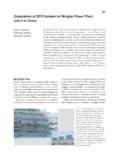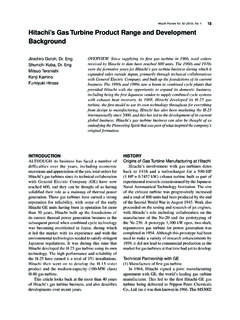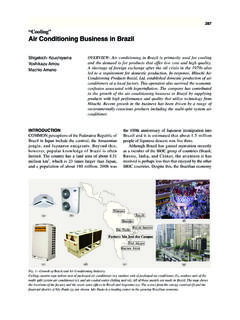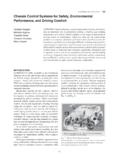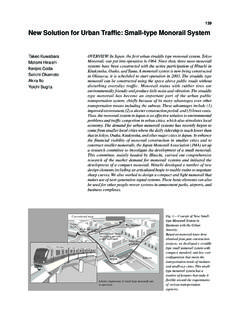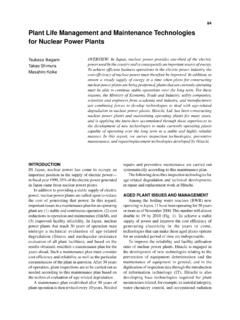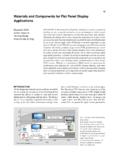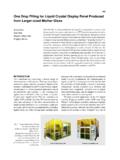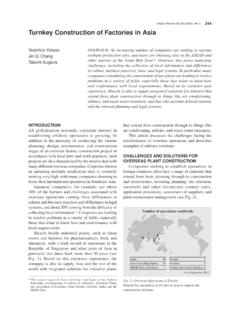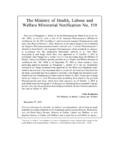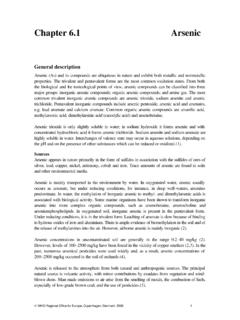Transcription of Analysis Guideline for the RoHS Directive Ver. 4
1 Analysis Guideline Revision Working Group Hitachi Group March 2018 Analysis Guideline for the RoHS Directive Ver. - 1 - Contents 1 Objective .. 2 Main purpose of revision .. 2 Scope of application .. 3 2 Abbreviations .. 3 3 Outline of the RoHS Directive .. 5 History of existing law and revision .. 5 Interpretation of homogeneous material .. 6 4 Analytical method and basic flow of Analysis .. 7 Principle of analytical instruments .. 7 Flow of analytical procedure .. 21 Sampling .. 23 5 Analytical method .. 25 Screening Analysis by X-ray fluorescence spectrometry .. 25 Cadmium, lead, chrome and their compounds .. 27 Mercury and its compounds .. 31 Hexavalent chromium and its compounds.
2 32 Specific brominated compounds (PBBs and PBDEs) .. 37 Phthalic acid esters .. 41 - 2 - Analysis Guideline for the RoHS Directive Ver. 1 Objective Main Purpose of Revision In response to the European RoHS Directive (2002/95/EC) published in January 2003 banning the use of the electric and electronic equipment containing the specific hazardous substances, the Environment Division (Current the CSR and Environmental Strategy Division) of Hitachi prepared the first version of this Guideline in April, 2004 to indicate to Hitachi Group companies the analytical method that complies with the RoHS Directive . At the stage of 2004, there was no official method to check the compliance with the RoHS Directive .
3 Therefore, individual business divisions and associated companies referred to this Guideline for the analytical method and interpretation and, established the control system of their own in cooperation with their partners and customers. Under such situation, IEC contemplated, during 2005 - 2008 in its IEC/TC111/WG3 (Test Methods), the standardization of the analytical procedures of the specific hazardous substances contained in the electric and electronic equipment, and produced IEC62321 in December, 2008 by integrating the results. As the standard of the official method was established, the analytical Guideline of Hitachi group clarified the conformity of IEC62321 in terms of the measurement procedure, and the content of the Guideline was expanded to become useful as operating guidelines by incorporating the basic descriptions of Analysis methods and an introduction to typical practices of the leading divisions, which resulted in the revision of the Guideline as the second version in November 2010.
4 Later in June 2011, the RoHS Directive in Europe was revised into the Directive 2011/65/EU, with additional category 8 (medical equipment) and category 9 (monitoring and control equipment), which had previously been out of the scope, now being regulated. And with the other electrical and electronic equipment not falling under categories 1 to 10 being newly established as category 11, all electrical and electronic equipments are now, as a rule, within the scope. In addition, preparation and storage of declaration of conformity for CE markings and technical documents were made obligatory. For restricted substances subject to the RoHS Directive (hereinafter referred to as "restricted substances"), Directive (EU) 2015/863, which revises Annex II of Directive 2011/65/EU, was issued in June 2015 to add four phthalic acid esters as restricted substances.
5 Additions are expected to be made regularly in the future. On the other hand, with the revision made in May 2013, it has been decided to issue IEC62321 as divided into abstract, sampling, screening, detailed Analysis method, or as classified by substance, along with incorporating PAS62596 a sampling Guideline . The Analysis methods for restricted substances likely to be added will also be issued. This Guideline is revised in response to the publication of Part 7-2 and Part 8 of IEC62321 in March 2017, which is intended to comply with IEC62321 as well as to supplement the - 3 - technically necessary matters. Therefore, it is expected to utilize this new Guideline for reducing the specific hazardous substances contained in the electronic equipment and to contribute to the environmental protection and improvement as well as to the health protection of the users by preventing the contamination due to the specific hazardous substances.
6 Scope of application This Guideline stipulates the analytical method to measure the content of the specific chemical substances contained in the constituents of the electric and electronic equipment, and applies to the products and their constituents regulated under the RoHS Directive . The content measured by this Guideline can be used, for example, for the determination of the threshold value stipulated in the RoHS Directive . Note: The international standard corresponding to this Guideline and the abbreviations to show the extent of compliance are indicated below: IEC62321 Ed. : 2008 (b), Electrotechnical products Determination of levels of six regulated substances (lead, mercury, cadmium, hexavalent chromium, polybrominated biphenyls, polybrominated diphenyl ethers) (MOD) The sign to denote the extent of compliance (MOD) shows the correction as per ISO/IEC Guide 21.
7 2 Abbreviations AAS Atomic Absorption Spectrometry ABS Acrylonitrile Butadiene Styrene AFS Atomic Fluorescence Spectrometry APCI Atmospheric Pressure Chemical Ionization ASTM American Society for Testing and Materials BL Below Limit CCS Calibration Check Standard CI Chemical Ionization CRM Certified Reference Material CV-AAS Cold Vapor Atomic Absorption Spectrometry CV-AFS Cold Vapour Atomic Fluorescence Spectrometry DecaBDE Decabrominated Diphenyl Ether DI De-ionized (water) DIN Deutsches Institut fuer Normung EDXRF Energy Dispersive X-ray Fluorescence EEE Electrical and Electronic Equipment EI Electron Ionization - 4 - EN European Norm EPA Environmental Protection Agency FEP Fluorinated Ethylene Propylene Copolymer FP Fundamental Parameter FRU Field Replaceable Unit GC-MS Gas Chromatography-Mass Spectrometry GLP Good Laboratory Practice HDPE High-Density Polyethylene HPLC-UV High-Performance Liquid Chromatography-Ultra Violet HIPS High-Impact Polystyrene IAMS Ion Attachment Mass Spectrometry IC Integrated Circuit IC Ion Chromatography ICP Inductively Coupled Plasma ICP-MS Inductively Coupled Plasma Mass Spectrometry ICP-OES Inductively Coupled Plasma-Optical Emission
8 Spectrometry IEC International Electrotechnical Commission IEC/TC111/WG3 (Test Methods) TC111 is a technical committee for compiling basic environmental and cross-product standards, technical reports, and other necessary guidelines in close collaboration with the various technical committees of IEC. WG3 is a working group that considers how to measure chemicals and other substances in electrical and electronics equipment. IS Internal Standard JIS Japanese Industrial Standard LLOD Low Limits of Detection LOD Limits of Detection MDL Method Detection Limit NMIJ National Metrology Institute of Japan NMP N-Methylpyrrolidone OctaBB Octabromo Biphenyl OctaBDE Octabromo Diphenyl Ether OL Over Limit PBB Polybrominated Biphenyl PBDE Polybrominated Diphenyl Ether PC Polycarbonate PCB Polychlorinated Biphenyl PCT Polychlorinated Terphenyl PCN Polychlorinated Naphthalene PE Polyethylene - 5 - PFA Perfluoro Alkoxy PFK Perfluoro Kerosene PFTBA Perfluoro Tributyl Amine PTFE Polytetrafluoroethylene PTV Programmable Temperature Vaporization injector PVC Polyvinyl Chloride Py-TD-GC-MS Thermal Decomposition/Desorption
9 Gas Chromatography Mass Spectrometry (Equipment) Note: In this Guideline , because measurements are performed without thermal desorption of Analysis samples, the term Thermal Desorption Gas Chromatography Mass Spectometry (Equipment) is used across the board. PWB Printed Wiring Board QA Quality Assurance QC Quality Control SIM Selected Ion Monitoring TD(G)-AAS Thermal Decomposition - Gold amalgamation - Atomic Absorption Spectrometry TD-MS Thermal Desorption Mass Spectrometry THF Tetrahydrofuran WDXRF Wavelength Dispersive X-ray Fluorescence XRF X-ray Fluorescence 3 Outline of RoHS Directive History of exiting law and revision In Europe, by enforcement of the RoHS Directive promulgated in February 2003 ( Directive 2002/95/EC), the restriction on the use of designated hazardous substances included in electrical and electronic equipments (EEE) came into force in July 2006.
10 Later, the largely revised version ( Directive 2011/65/EU) was promulgated in July 2011 and has been virtually enforced since January 2013 (the deadline for member countries to establish related domestic laws). (The first edition is called RoHS1 and revised one is called RoHS2.) Electrical and electronics equipments (EEE) to be restricted broadly refers to "equipment designed for use at rated voltages not exceeding 1,000 V AC and 1,500 V DC" as divided into 11 total categories, comprising 10 designated product groups (categories 1 to 10) and a category of all other products (category 11). The restriction under this Directive was initially applied to categories 1 to 7 and 10 (home electronics, communications equipment, lighting equipment, motor-driven tools, toys, automatic vendors, and other equipment).
